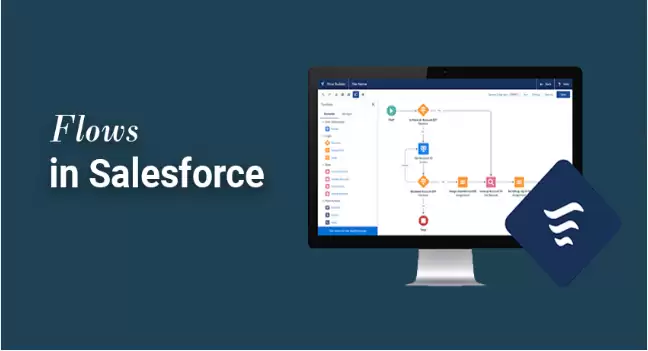Definition of Salesforce Flow Builder
Salesforce Flow Builder is a visual tool that helps businesses automate their processes by creating automated workflow applications. It allows users to create automated workflows, business processes, and data manipulation without the need for coding or complex programming. With this tool, businesses can streamline their procedures and improve productivity.
The Salesforce Flow Builder has a drag-and-drop interface that makes it easy for users to build flows quickly. These flows can be used to automate any process in Salesforce or outside of it using APIs. Flows can also be created to update records, send emails, create tasks, and perform other actions based on predefined conditions.
Salesforce Flow Builder comes with pre-built templates that help users get started with building workflows quickly. Users can also create custom flows from scratch or modify existing ones as needed. The tool is designed to be flexible enough to accommodate different business needs and use cases while being user-friendly enough for non-technical users to operate easily.Take your career to the next level in Salesforce Join Salesforce Training.
Benefits of using Salesforce Flow Builder
Salesforce Flow Builder is a powerful tool that empowers users to automate complex business processes without any programming knowledge. This tool provides an easy-to-use, drag-and-drop interface that allows you to create, update, and delete records in Salesforce quickly. With the help of Salesforce Flow Builder, users can streamline their workflows, reduce response times and enhance overall productivity of their organization.
One of the main benefits of using Salesforce Flow Builder is its ability to automate repetitive tasks. By automating routine processes such as lead qualification or opportunity creation, employees can save time and focus on higher value tasks. Additionally, automation ensures consistency in processes which reduces errors and increases efficiency across teams.
Another advantage of using Salesforce Flow Builder is its flexibility. It allows you to customize your flows according to your specific needs. You can create custom screens with fields specific to your business requirements or integrate external applications into your flow for more streamlined operations. The intuitive drag-and-drop interface makes it easy for non-technical users to build flows that are tailored exactly to their needs.
Comparison to other Salesforce automation tools
Salesforce flow builder is just one of several automation tools available on the Salesforce platform. Another popular option is Process Builder, which allows users to automate complex business processes by setting up a series of conditions and actions. While both Flow Builder and Process Builder have similar capabilities, there are some key differences between the two.
For example, Flow Builder offers more flexibility in terms of the types of automation it can handle. Unlike Process Builder, which is limited to specific actions and conditions, Flow Builder allows users to create custom screens and forms for data entry and manipulation. This makes it a great choice for businesses that need more robust automation capabilities.
Another popular Salesforce automation tool is Apex Triggers. This tool allows developers to write custom code that will be executed when certain events occur in Salesforce, such as the creation or modification of a record. While Apex Triggers can be incredibly powerful, they require more technical expertise than either Flow Builder or Process Builder, making them less accessible for non-technical users.
Accessing Flow Builder
Flow Builder is an innovative tool that helps Salesforce users create, automate, and simplify complex business processes. It provides a visual representation of the workflow process and enables users to drag-and-drop elements into a flow diagram to build their own custom flows. To access Flow Builder, you must have a Salesforce account with appropriate permissions.
Once logged in, navigate to the Setup menu and select Process Automation > Flow from the left-hand menu. From there, click on the New Flow button at the top right corner of your screen to begin building your flow. You can also edit existing flows by selecting them from the list of available flows.
In addition to building custom flows, Flow Builder also offers pre-built templates for common use cases such as lead routing or approval workflows. These templates can be customized to meet specific business needs or used as-is for quick implementation. With its user-friendly interface and robust capabilities, accessing Flow Builder is essential for any organization looking to streamline their business processes and increase efficiency.
Creating a new Flow
Salesforce Flow Builder is a powerful tool that allows users to automate business processes and streamline workflows. Creating a new Flow in Salesforce Flow Builder is quick and easy, and can be done in just a few simple steps. To create a new Flow, users must first navigate to the Flow Builder page within their Salesforce account.
Once there, they can choose to create a brand new flow from scratch or use one of the many pre-built templates available. When creating a new flow from scratch, users will need to define the input variables that will be used throughout the process. These variables can then be passed into various actions and decision elements within the flow.
With their input variables defined, users can begin adding elements to their flow such as assignments, loops, screens for user input and more. Once all necessary elements have been added, it’s important to test the flow thoroughly before activating it. Overall, creating a new Flow in Salesforce Flow Builder offers businesses an efficient way to automate repetitive tasks and improve overall productivity in daily operations.
Basic components of a Flow
Salesforce Flow Builder is a powerful tool that allows users to automate complex business processes without writing any code. With Flow, users can create custom screens, collect data from users, and perform actions like creating records or sending emails. To build an effective flow in Salesforce, it’s important to understand the basic components of a flow.
The first component of a flow is the starting point. This could be a button on a record page or an event trigger that kicks off the flow. Next up is the screen element which provides users with an input interface for entering data into variables that will be used throughout the rest of the process.
After configuring screens, you can add various types of elements – such as decision elements which help guide your process based on certain conditions; loop elements which allow you to iterate through records and collections; record update elements for updating fields within records and more – depending on your use case.
By understanding these basic components of Salesforce Flow Builder along with others like formulas and connectors (Salesforce integrates with other third-party apps), you can easily create automated business processes to improve productivity and gain insights into your organization’s performance.
Conclusion
In conclusion, Salesforce Flow Builder is a powerful automation tool that enables users to create custom business processes and automate repetitive tasks. It allows users to build Flows using a drag-and-drop interface without the need for coding, making it accessible to non-technical users.
Flow Builder has many features and capabilities, including the ability to create decision logic, interact with external systems, and incorporate Apex code. It also includes advanced features like sub flows, reusable components, and debugging tools.








